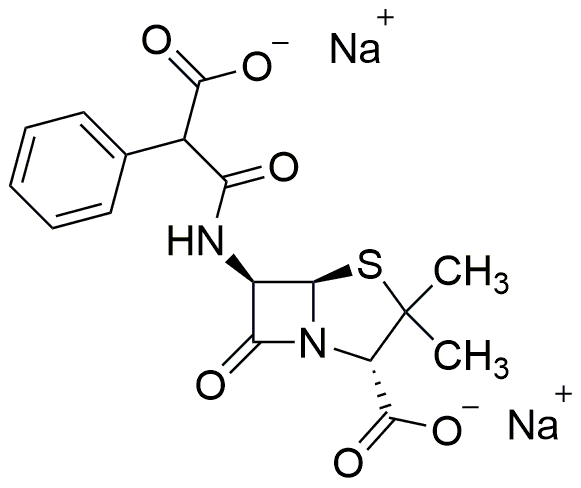Carbenicillin disodium salt is widely utilized in research focused on:
- Antibiotic Development: This compound is primarily used in the development of antibiotics, particularly for treating infections caused by Gram-negative bacteria. Its effectiveness against resistant strains makes it a valuable tool in pharmaceutical research.
- Clinical Applications: In the medical field, it is employed for treating various bacterial infections, especially in patients with compromised immune systems. Its broad-spectrum activity helps in managing serious infections.
- Laboratory Research: Researchers use carbenicillin disodium salt in microbiology labs to select for genetically modified organisms that carry antibiotic resistance markers, facilitating studies in genetic engineering and molecular biology.
- Pharmaceutical Formulations: It is incorporated into various pharmaceutical formulations, enhancing the stability and efficacy of antibiotic treatments. This is crucial for ensuring that medications remain effective over their shelf life.
- Veterinary Medicine: The compound is also applied in veterinary medicine to treat infections in animals, ensuring their health and well-being. Its use in livestock can help prevent the spread of bacterial diseases.
General Information
Properties
Safety and Regulations
Applications
Carbenicillin disodium salt is widely utilized in research focused on:
- Antibiotic Development: This compound is primarily used in the development of antibiotics, particularly for treating infections caused by Gram-negative bacteria. Its effectiveness against resistant strains makes it a valuable tool in pharmaceutical research.
- Clinical Applications: In the medical field, it is employed for treating various bacterial infections, especially in patients with compromised immune systems. Its broad-spectrum activity helps in managing serious infections.
- Laboratory Research: Researchers use carbenicillin disodium salt in microbiology labs to select for genetically modified organisms that carry antibiotic resistance markers, facilitating studies in genetic engineering and molecular biology.
- Pharmaceutical Formulations: It is incorporated into various pharmaceutical formulations, enhancing the stability and efficacy of antibiotic treatments. This is crucial for ensuring that medications remain effective over their shelf life.
- Veterinary Medicine: The compound is also applied in veterinary medicine to treat infections in animals, ensuring their health and well-being. Its use in livestock can help prevent the spread of bacterial diseases.
Documents
Safety Data Sheets (SDS)
The SDS provides comprehensive safety information on handling, storage, and disposal of the product.
Product Specification (PS)
The PS provides a comprehensive breakdown of the product’s properties, including chemical composition, physical state, purity, and storage requirements. It also details acceptable quality ranges and the product's intended applications.
Certificates of Analysis (COA)
Search for Certificates of Analysis (COA) by entering the products Lot Number. Lot and Batch Numbers can be found on a product’s label following the words ‘Lot’ or ‘Batch’.
*Catalog Number
*Lot Number
Certificates Of Origin (COO)
This COO confirms the country where the product was manufactured, and also details the materials and components used in it and whether it is derived from natural, synthetic, or other specific sources. This certificate may be required for customs, trade, and regulatory compliance.
*Catalog Number
*Lot Number
Safety Data Sheets (SDS)
The SDS provides comprehensive safety information on handling, storage, and disposal of the product.
DownloadProduct Specification (PS)
The PS provides a comprehensive breakdown of the product’s properties, including chemical composition, physical state, purity, and storage requirements. It also details acceptable quality ranges and the product's intended applications.
DownloadCertificates of Analysis (COA)
Search for Certificates of Analysis (COA) by entering the products Lot Number. Lot and Batch Numbers can be found on a product’s label following the words ‘Lot’ or ‘Batch’.
*Catalog Number
*Lot Number
Certificates Of Origin (COO)
This COO confirms the country where the product was manufactured, and also details the materials and components used in it and whether it is derived from natural, synthetic, or other specific sources. This certificate may be required for customs, trade, and regulatory compliance.


